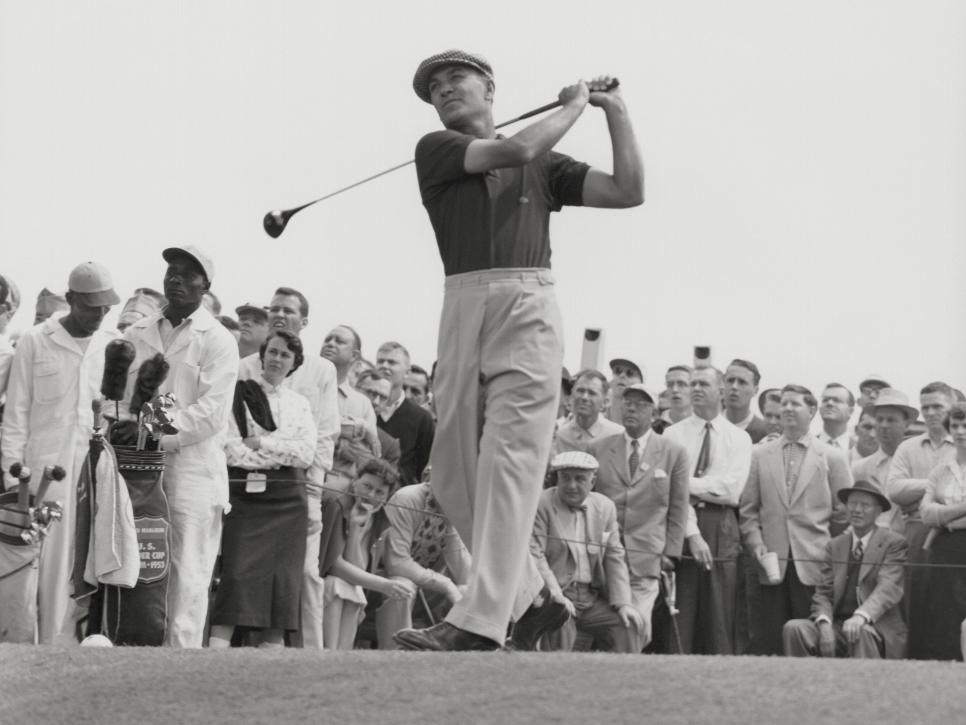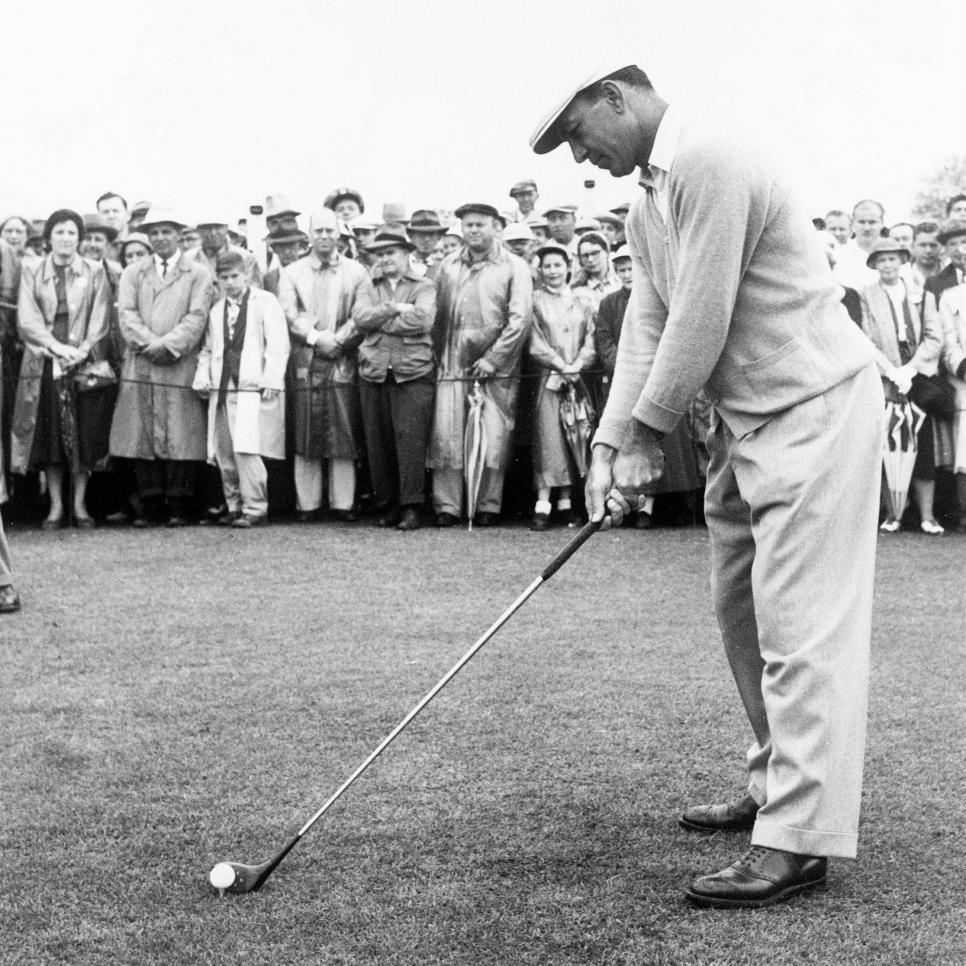News
If Ben Hogan met TrackMan ...

“The ball did not so much fly from left to right and obviously curl off, as anyone else’s might. It traveled like someone struggling to enter a jam-packed subway train in New York or Tokyo, pushing against a mass of back muscles, rumps, and elbows; there was the slightest amount of give, but no penetration.” —Al Barkow, Golf’s Golden Grind
Of all the shots in Ben Hogan’s mighty arsenal—and he had them all—there’s one that’s still regarded as the single greatest shotmaking weapon in golf history. The Hogan fade, played as only he could play it, was by all accounts a different type of ball flight entirely, something unique and never duplicated since.
What was that fade like? How did the ball behave exactly? Common recollections have it coming off the clubface with tremendous speed, starting on a trajectory shading on the low side. The ball maintained a flattish flight, never taking on the rainbow-like arc of ordinary driver shots. At a point in its flight where the eyes tell you the ball is about to stall a bit and come down, it did something magical.
“It kind of turbo-boosted,” says Chuck Cook, the Texas teacher, who as a young man in the 1970s spent two days alone watching Hogan practice at Shady Oaks in Fort Worth , well after Hogan had stopped competing. “I don’t know how else to describe it. It seemed to re-energize itself and keep going.”
The ball continued forward on a dead-straight line, reaching the peak of its flight. Only when it began to fall did it take on the fading characteristic, moving left-to-right very gently, perhaps a few yards. Even then the strangeness of it wasn’t complete. Rather than settle abruptly as all fades played with persimmon and balata tended to do, it rolled after landing.
“I’ve never seen anything like it since, except by a good player who sometimes hits it by accident,” says Cook, who over the last several years has taught Jason Dufner, Luke Donald, Keegan Bradley and others. “It really changed me as a teacher. There was something about the way he delivered the clubhead into the ball that made me realize I had a lot to learn.”
‘He was a human launch monitor, a living, breathing TrackMan. He was a machine.’ —Jim McLean
Says Jim McLean, one of the world’s greatest instructors and a Hoganphile who authored the fine The Complete Hogan, “You can imagine what that fade looked like when Hogan was at his peak. He was a very long hitter, you know. He visited Spalding one time, and they had a radar device that measured clubhead speed. Hogan with the driver clocked at 132 miles per hour, the fastest among all the pros.”
“He was a human launch monitor, a living, breathing TrackMan,” says McLean. “He was a machine.”
Which brings us to the mission of this article. Can the famous Hogan fade be quantified? If we could strap a TrackMan and computer into a time machine and ship it back to, say, 1953, and Hogan produced the best example of his unique power fade, what would the numbers be? What freakish set of impact conditions was he performing that would produce such a divine ball flight?

Augusta National
Over the last couple of years, I’ve slipped this question in passing to many of the world’s best teachers, all of whom embraced the conceit. Cook and McLean were quick to produce the most meaningful numbers. David Leadbetter, teacher to so many superb players and author of The Fundamentals of Hogan, came back overnight. Also checking in were Sean Foley, present teacher to Justin Rose and once upon a time, Tiger Woods. Rounding out the lineup were Charlie Epps the veteran Houston teaching pro who teed it up with Hogan, and Joe Mayo, one of several modern teachers who use TrackMan as a focal point of their teaching.
From their assessments came three rock-solid conclusions. The teachers, as different though as their approaches to the golf swing may be, arrived at stunningly similar numbers. No single instructor’s assessment deviated from another’s by more than one degree in any aspect. Here are the three chief takeaways:
Through impact, Hogan’s clubhead was traveling slightly to the left of the target.
McLean sees the path at a modest -1, a single degree to the left. So does Epps. Mayo also opts for -1, and Cook shades it in that ballpark as well. Only Leadbetter ventures it was as far as -2, which is still nowhere near where weekend slicers have it. The thing to know about the leftward path is that Hogan did not cut across the ball in the manner typical slicers do. This was no over-the-top action. He delivered the ball powerfully from inside the line of play, allowed it to track down the line briefly, then had it exiting a hair back to the inside at the moment of truth. It’s one of the essences of his unique fade, because this way there was no loss of power.
A slight outlier here was Foley. He believes Hogan probably was “zeroed out” at impact—the club traveling dead down the target line—and also had clubface angle of 0. So how did Hogan fade it? His theory—a darned creative one—is that Hogan deliberately contacted the ball a hair toward the heel of the club, letting the gear effect of his driver impart a fading spin on the ball.

Augusta National
Hogan hit slightly down on the ball.
All the teachers believe Hogan was -1 on “AOA”—angle of attack. It means he delivered a slight descending blow with the driver. Epps and Leadbetter point out that Hogan teed the ball low—photographic evidence supports this (see above)—and that an upward AOA is unlikely. “When I look at the fact that he took divots with his 3-wood, well, the driver is not that far apart from a fairway wood,” Leadbetter says.
How, one might wonder, did Hogan avoid hitting “upshooters” with the downward hit on those old balata balls? “At impact, the clubface was in the process of working down, ‘covering’ the ball through impact,” McLean says. “The bowed left wrist, the shaft not leaning back, show that he really compressed the ball against the center of the clubface. Hogan was one of the very few faders of the day who didn’t lose distance. Jimmy Demaret could do it. So could a really good player named Paul Harney. But it was very rare.”
Hogan’s clubface was aimed dead at the target.
The near-universal belief that Hogan swung the club slightly to the left through impact requires that his clubface not be open relative to the target. An open clubface combined with a leftward path, is a lethal combination—slice city. Thus, the teachers who voted for a -1 path, all combined it with a clubface that was at 0—perfectly square to the target line. This indicates that Hogan was, above all, a “path fader.” The very slight left-to-right fade he imposed—again, we’re talking a few yards here—was the result of his path, not an open clubface. One teacher (Leadbetter) suggested that Hogan’s clubface could have been -1, or closed to the target line. But he combines it with a path that was possibly -2, making it a safe and reasonable opinion.
Do the numbers fully explain the unique character of Hogan’s bread-and-butter ball flight? Certainly it’s an outline, but there has to be more. McLean point out that there are many tour players who are capable of duplicating these basic numbers, albeit without Hogan’s numbing consistency. So what was the secret sauce, the peculiar and perhaps unmeasurable element that elicited crowded-subway analogy from Al Barkow? Foley suggests that a unique, combination of other Trackman measurements—launch angle, dynamic loft, spin loft, the ball’s spin axis and spin rate, for example—could further contribute to Hogan’s profoundly efficient ball flight.
There were other, unconsidered forces at work we know Hogan employed. The specs of his driver were unique, beginning with the strong flex of his True Temper and later, Apex, shafts. The clubhead was not off-the-rack, either, and Hogan tweaked and maintained it in marked ways. But what was Hogan looking for when he inspected the amount of paint on each ball he put into play? Why did he scold his shag boy, Jody Vasquez, for scraping the dirt out of the grooves of his driver?
Like so many great historical mysteries, the Hogan fade is being chipped away at, bit by technological bit. We know more than we started. But for the most part it endures, a cool and wonderful artifact left for everyone to explore. “I think it’s awesome that there are things we still don’t know, secrets about that ball flight Hogan didn’t disclose,” Mayo says. “It’s a gift. There’s a lot to say about not saying a lot.”

